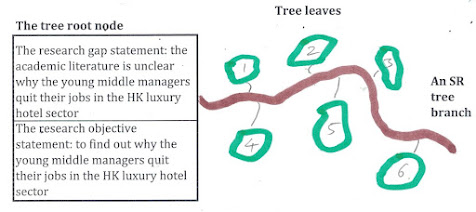On the literature search task to construct an academic literature review tree: a note on the subject the agile literature review approach (the academic-oriented project type).
An academic literature review tree branch has the following generic structure:
The tree root node is where a pair of lower-level research gap and objective statements is located.
The tree leaves are the academic ideas gathered via the literature search and review effort of the researcher. In this case, leaf 1 is the academic idea 1, leaf 2 is the academic idea 2, and so on and so forth.
The tree branch is where all the tree leaves are anchored on; there are two types of tree branch, i.e. the scientific reasoning (SR) tree branch and the design thinking (DT) tree branch. An academic literature review tree should have more than 1 tree branch and tree root node
A concrete example of a tree branch
This example is taken from my previous blog note on academic literature review tree.
How about the literature search and review exercise to collect academic ideas as the tree leaves for this tree branch? Here, I offer three suggestions to do so:
Suggestion 1: The tree root node was formulated based on the initial literature review. More specifically, it is informed by the following academic article (re: blog note):
Nguyen, T.H. and Loo, P.T.. 2024. "“Boss, I am gonna to quit!!!” The resignation experiences of hotel employees in Vietnam" International Journal of Hospitality Management 119, Elsevier 103726.
As this academic article from Nguyen and Loo (2024) has a list of references, the research student could take a closer look at this list of references to search for academic ideas to use for his/her own literature search and review exercise. This is one way to collect some tree leaves for this tree branch construction.
Suggestion 2: Make use of the key words in the pair of research gap and objective statements to perform literature search on the university e-library. For this example, the key words are: quit jobs, job turnover, job retention, job turnover + hotel sector, job retention + hotel sector, manager job turnover; manager job retention, middle managers quit job, middle manager job turnover, etc...; the process of literature search and review funnel approach is useful for this exercise.
Suggestion 3: On deciding whether an academic idea is relevant for this academic literature review tree construction, also consider the academic tree branch type. In this example, the tree branch type is SR (scientific reasoning type, with the main research effort being: to describe, to predict and to explain). Thus, if you figure out that a candidate academic idea is useful for this SR research effort, it probably is a useful one for a tree leaf for this academic literature review tree branch.


No comments:
Post a Comment